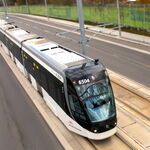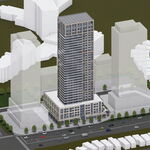This is not true. Here are some high-speed turnouts in the United States that are not on the Northeast Corridor that I found with a few minutes of googling:
- 60 mph (97 km/h) turnout on the BNSF Bakersfield Subdivision at milepost 892.4 Lopez
- 80 mph (129 km/h) turnouts on the Long Island Rail Road at Queens interlocking
- 80 mph (129 km/h) turnout on the Brightline Orlando subdivision at control point Orlando West:
Well, any express train that needs to switch to an express track away from the start/end of its express segment (e.g. at Guildwood, Mimico, etc) currently needs to slow to 45 mph to turn out. Any location where trains meet on a single track line away from a station (e.g. in Breslau), trains need to slow to 45 mph to turn out. If the turnout speed were higher, those trains wouldn't need to slow down as much.
Sure, we could design the network with enough tracks that express trains never need to switch away from the start and end of their express segments, but that would require building way more tracks (i.e. lots more quad track rather than triple track, and double track rather than single track).
As I mentioned above, high-speed turnouts do exist in North America. And besides, we're not talking about North America vaguely, we are talking about the Metrolinx-owned portions of the GO Transit network, which have minimal freight traffic.
Well ONExpress is proposing to install ETCS, in which case there's really no limitation on what speed can be indicated. I always found it hilariously constricting that the Canadian signalling standard requires locomotive operators to memorize a bunch of different combinations of colours and flashing indications corresponding to a specific set of speeds, instead of just putting the currently permitted speed on the signal like the ATB system does in the Netherlands. Not that that matters now anyway, since ATB is being replaced by ETCS.
Well I would think that the usefulness of an 80 mph turnout is that if the track speed is 80 mph (129 km/h) you don't need to slow down to 45 mph (72 km/h) to change tracks, like you would with a standard turnout. As for the indication, how about "green over red, full speed ahead". It's also worth noting that equilateral switches are much smaller and cheaper than an asymmetric switch with the same turnout speed. So an equilateral switch where both routes allow 80 mph is much smaller and cheaper than the switch in the video above that allows 80 mph diverging and 125 mph tangent.
High speed switches are far more complex to maintain than standard switches so they definitely wouldn't be installed without good reason, but in the places where they allow a lot of trains to avoid slowing down, they also provide a lot of benefit in terms of reduced travel time and reduced energy consumption. And both of those things are good for the bottom line.




